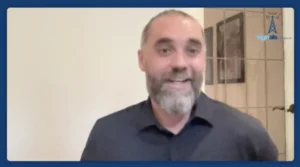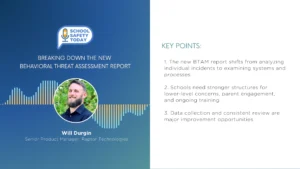Digital tools have changed the way we think about teaching and learning. You might host a virtual guest speaker in your classroom, or empower students as website designers or moviemakers. Today we have new ways to help students interact with the world — in every grade level and subject area.
So how can educators use these same powerful tools to learn and grow as professionals? Jacie Maslyk has served as an educator in a variety of roles. She’s taken her experience as a connected educator and created an actionable resource for anyone interested in expanding their network and growing as an educator.

Becoming a Connected Educator
Connect to Lead: Power Up Your Learning Network to Move Your School Forward, was released by ISTE earlier this year. Jacie was kind enough to answer my questions about her new book. In this blog post, you’ll find the full interview, more information on Connect to Lead, and ways to connect with Jacie in different social spaces!
What motivated you to write a book on this topic?
Too often in education, we work in isolation; keeping to our own classrooms, within the same four walls. Learning is so much bigger than that! We can expand learning for our students, for educators, and for school leaders when we develop collaborative networks. There are so many amazing learning networks that exist, both virtually and face-to-face, that educators can learn about in this book.
Why is this topic important to you?
I have grown personally and professionally by being a connected educator. In addition, I have watched educators thrive when they are able to build relationships with other educators and organizations outside of education. It is this interconnectedness that creates new opportunities for students, teachers, and school systems.
The POWER UP Framework
What are some of the benefits of “powering up your learning network” this school year?
The POWER UP Framework provides some guidelines for school and district leaders to create more connections within their organizations and beyond. For example:
- Think outside the box to develop partnerships for your school or district. A local flower shop, a bank, or a grocery store can provide learning experiences for students and resources for teachers.
- Reflect on the professional learning within your district. Do you provide opportunities for differentiated development for educators? Do you plan these opportunities with equity in mind? Map out one way that you can provide more choice or collaboration in your PD plans.
In your book, you discuss pathways to connected learning, including “take risks.” How can a school leader embrace risk-taking?
One of my favorite quotes is from Milton Berle. He said, “If an opportunity doesn’t knock, build a door.” Sometimes as school leaders we don’t have access to the right resources or opportunities that we want to provide. If those things don’t exist, then it’s our job to make it happen!
Trying something new can be risky for some, but with great risk comes great reward. Exploring unconventional methods, designing new learning opportunities, or creating a network of learners and leaders can be a risk. When leaders take a chance and break the status quo, we can create a culture of collaboration. We are building new doors every time we take a risk that can create new learning for those we serve.
Leading as a Connected Educator
Is there a favorite story of powerful connections you like to share when working with educators?
Five years ago, I changed jobs and began working in a different county in western Pennsylvania. The school districts there did not work cooperatively as had been my experience in a previous county. I struggled professionally without the support of a collaborative network to share ideas and learn together. Since there wasn’t a door, I had to build one!
Working with leaders from two local school districts, we created our own organization. It would focus on collaboration across our county with a focus on creativity and innovative practices in schools. Our group, the Beaver County Innovation and Learning Consortium have worked over the last three years to provide shared professional learning experience across school districts. We’ve written grants together to create innovative learning spaces and advance STEM and computer science in our schools.
We have recently expanded our consortium to include two more school districts and have worked with three cohorts of teachers, principals, and district-level administrators. Through this experience, we’ve had teachers establish co-teaching opportunities across schools and districts. We’ve had curriculum collaboration across grade levels and subject areas. Proudly, we have also had teachers from three different school districts present at local and state conferences about the power of their learning network.
Hosting a Book Club
What advice would you give a group of educators who want to hold a book club for your book?
Each chapter in Connect to Lead ends with a section called The Power of 3-2-1. Here, readers will find three action steps to take. Readers can use these as discussion points. They will also find two educators to follow on social media which may lead them to great blog posts, Twitter chats, and podcasts hosted by these #Connect2Lead educators. Lastly, they will find one learning network that they can learn more about. These features can all be used as a part of a book study.
I would love to support any group of educators who want to hold a book club for Connect to Lead. Educators can contact me directly for a book club guide. I’d be happy to offer a live webinar for any book clubs that are happening this year.
How can readers connect with you and learn more about your work?
Readers can hear more about my work through my blog at or on my website. They can also connect with me on Twitter @DrJacieMaslyk or email me at jaciemaslyk@gmail.com.
Use the links above to connect with Jacie! And head over to Amazon to pick up a copy of her new book, Connect to Lead: Power Up Your Learning Network to Move Your School Forward. The folks at ISTE were kind enough to send along a copy for me to check out and I can’t wait to hear what you think!
***
This article was written by Monica Burns, Ed.D., and originally published on ClassTechTips.com. Monica is the author of Tasks Before Apps and host of Easy EdTech Podcast. You can follow her work on Instagram and Twitter @ClassTechTips.
This post contains affiliate links. The author may receive compensation if you click on one of the links.








